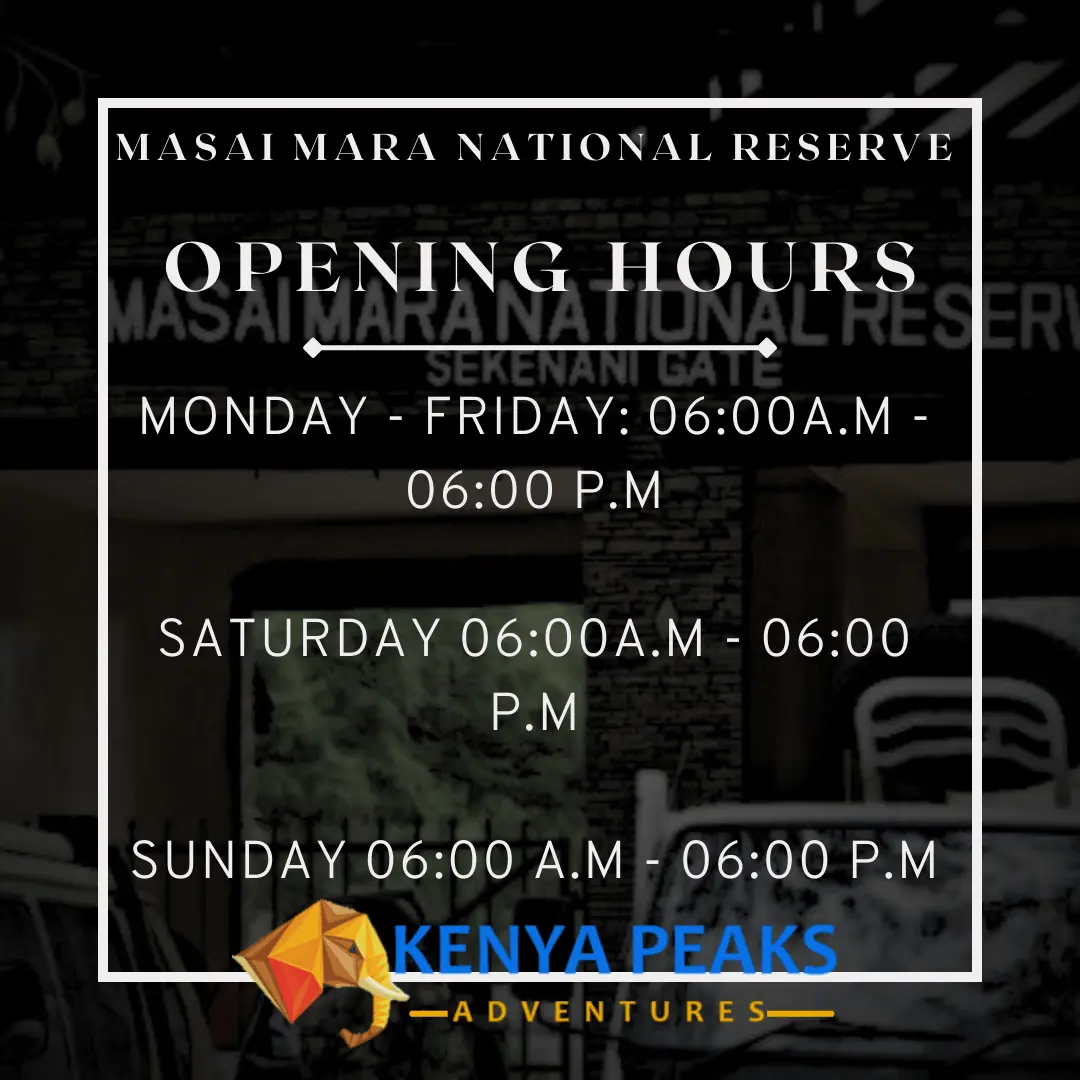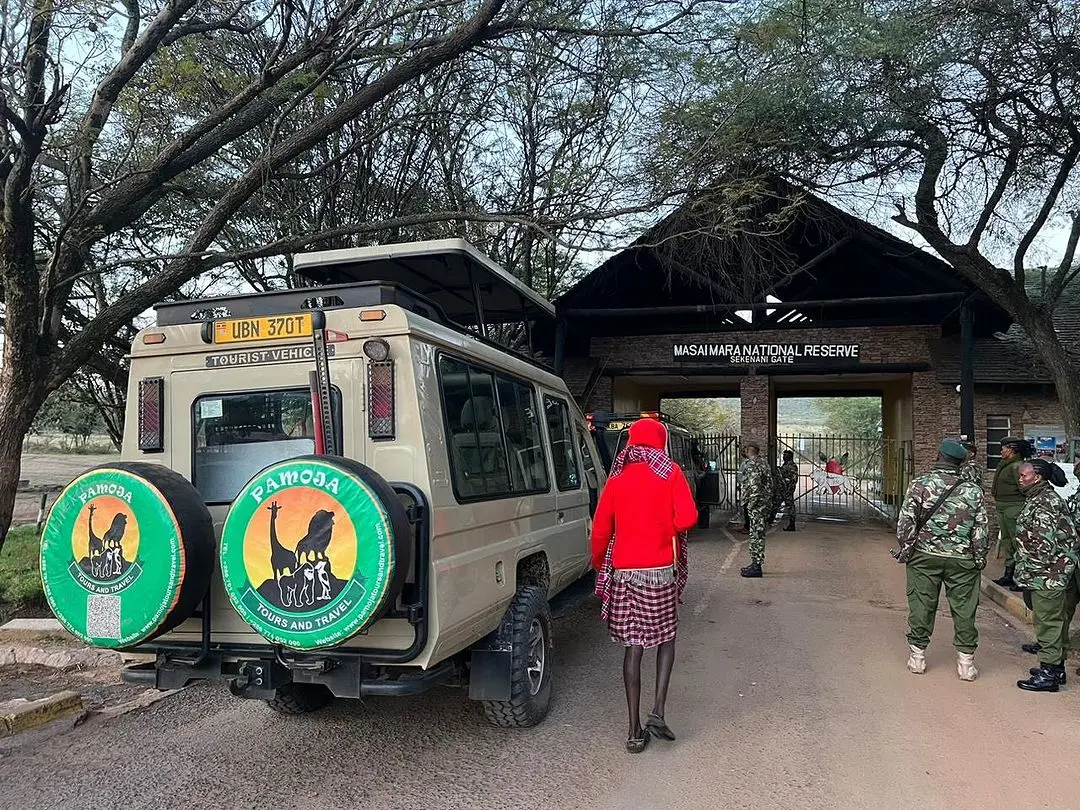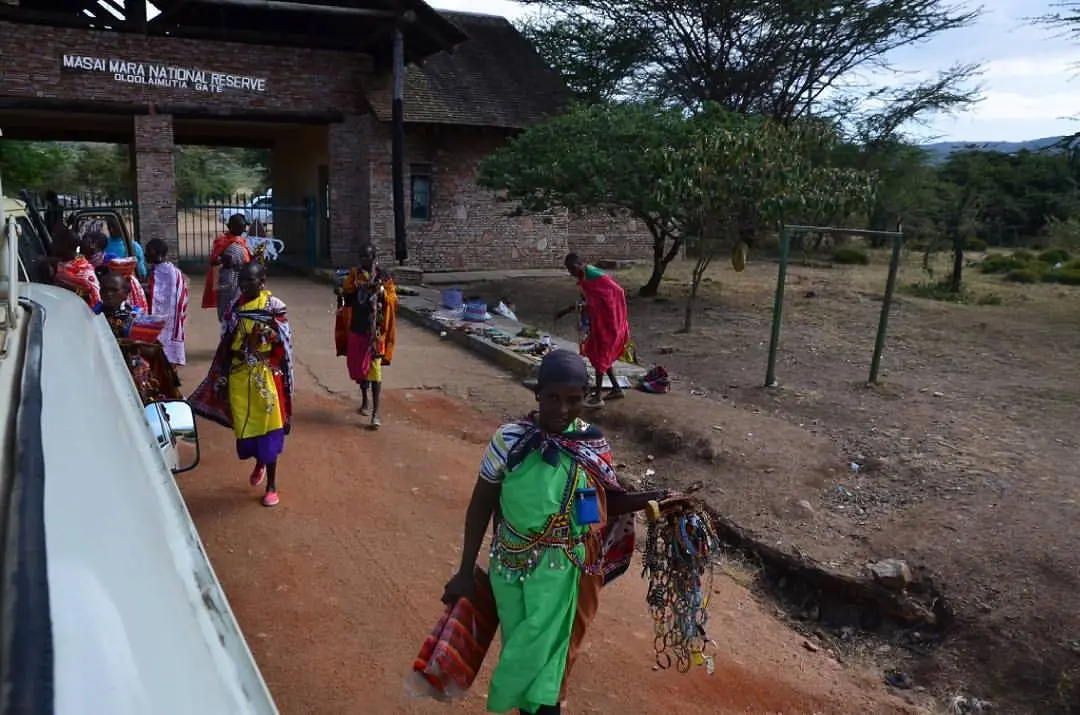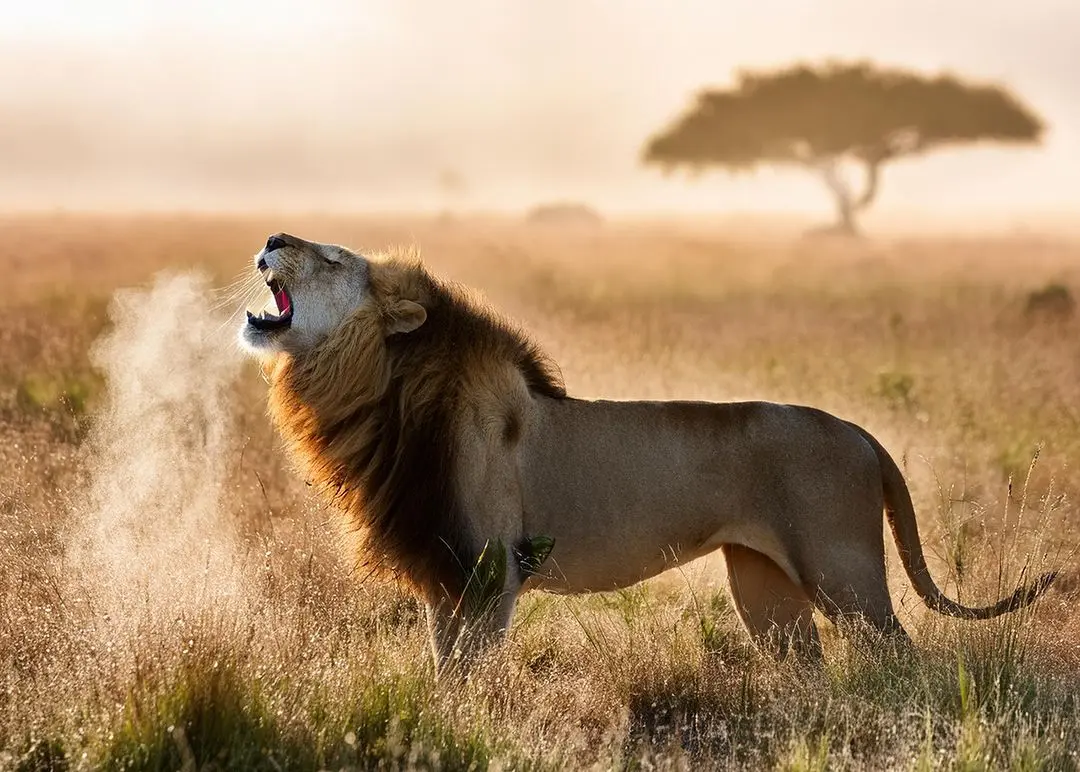
Masai Mara National Reserve is one of the popular safari tour destinations in Kenya that is renowned for the big 5 and the great wildebeest migration.
The reserve operates on specific opening and closing hours, designed to maximize visitor experience while ensuring the safety of both wildlife and tourists.
|
Gate Name |
Opening Time |
Closing Time |
Note |
|
Sekenani Gate |
6:00 AM EAT |
6:00 PM EAT |
Main entry, eastern border |
|
Talek Gate |
6:00 AM EAT |
6:00 PM EAT |
Popular, northwestern side |
|
Musiara Gate |
6:00 AM EAT |
6:00 PM EAT |
Northeastern end, near Mara River |
|
Oloololo Gate |
6:00 AM EAT |
6:00 PM EAT |
Accessed from the northeast |
|
Oloolaimutia Gate |
6:00 AM EAT |
6:00 PM EAT |
Near Oloolaimutia Town, eastern end |
|
Sand River Gate |
Closed |
Closed |
Near Kenya-Tanzania border |
Gate Hours and Regulations at Masai Mara
Masai Mara National Reserve enforces specific hours of operation to ensure both the preservation of its ecosystem and the safety of its visitors. The standard gate hours are from 6:00 AM to 6:00 PM Eastern African Time (EAT) for all gates, providing ample time for day visitors to enjoy the reserve.
Exceptions to Standard Hours
While the gates are consistently open from 6:00 AM to 6:00 PM EAT, there are exceptional circumstances where these times may be adjusted:
- Exceptions for Entry and Exit: In rare cases, such as vehicle breakdowns or medical emergencies, entry or exit may be permitted beyond the standard hours. However, this requires explicit permission from the reserve warden and is strictly controlled to minimize disturbances to the wildlife.
- Late Exit Penalties: Visitors planning to leave the reserve by road after the designated time (specifically later than 10:00 AM without proceeding further into the reserve) are subject to an exit fee. This rule is enforced to encourage timely departures and ensure that all visitors are accounted for before dusk.
Compliance and Enforcement
Strict adherence to gate hours is crucial for the following reasons:
- Wildlife Protection: Limiting the hours of operation helps reduce the impact of human presence on the natural behaviors of wildlife.
- Visitor Safety: Ensuring all visitors exit before dusk minimizes the risks associated with wildlife encounters and navigational challenges in the dark.
- Regulation Enforcement: Park officials are diligent in closing the gates promptly at 6:00 PM EAT, and any deviations from this schedule are monitored closely.
Gates at Masai Mara National Reserve

The Masai Mara NR has 6 main gates. Visitors can use 5 of the 6 gates because the Sand River Gate is currently closed. Our tour guides and drivers have used all these gates and here are the insights about each gate.
Sekenani Gate
Location: Main entry point, situated on the eastern border of the reserve.
Advantages: Most direct access from Nairobi, making it highly convenient for most tourists. The road leading to Sekenani is generally well-maintained, offering a smooth drive.
Talek Gate
Location: Positioned on the northwestern side of the reserve.
Advantages: Offers immediate access to the Talek River area, which is rich in wildlife. Ideal for visitors staying in camps and lodges situated in the northwestern parts of the reserve.
Musiara Gate
Location: Located on the northeastern end, near the Mara River.
Advantages: Best for accessing the Mara River, famous for the wildebeest migration crossings. Close proximity to several prominent camps.
Oloololo Gate
Location: Accessed from the northeastern region of the reserve.
Advantages: Provides quick entry to the Mara Triangle, less crowded and rich in wildlife. Suitable for those staying in the Mara Triangle or western conservancies.
Oloolaimutia Gate

Location: Near Oloolaimutia Town on the eastern end.
Advantages: Good for visitors coming from the eastern conservancies or those staying near Oloolaimutia village. It serves as a less crowded alternative to the Sekenani Gate.
Sand River Gate (Currently Closed)
Location: Situated on the southern border, near the Kenya-Tanzania border.
Note: It is currently closed due to its proximity to the border, emphasizing the need for security and controlled access.
Choosing the right gate involves considering your accommodation location within or around the reserve, your travel route, and your wildlife viewing priorities.
Using the correct gate can save hours of driving on unpaved roads, allowing more time for game viewing and less time commuting within the reserve.
Best Time to Visit Masai Mara
Visiting Masai Mara National Reserve at the right time of year can dramatically enhance the wildlife viewing experience, particularly during the world-renowned wildebeest migration.
Best Times to Visit
- Wildebeest Migration (July to October):
The most spectacular time to visit the Masai Mara is during the wildebeest migration, which generally occurs from July to October.
This period offers dramatic scenes of millions of wildebeest, along with zebras and gazelles, moving across the plains and rivers, pursued by predators such as lions, cheetahs, and crocodiles.
- Dry Season (June to October):
Aside from the migration, the dry season is excellent for wildlife viewing as animals congregate around water sources, making them easier to spot. The vegetation is also less dense, which improves visibility.
- Bird Watching (November to April):
For bird enthusiasts, the rainy season from November to April is ideal as it attracts an array of migratory birds. The reserve becomes lush and green, offering a beautiful backdrop for photography.
Daily Wildlife Viewing Tips

Morning Hours:
Animals are most active during the early morning hours, just after the gates open at 6:00 AM EAT. This is the best time to witness hunting activities, especially of nocturnal predators like lions and hyenas.
Late Afternoon:
Late afternoon, leading up to the closing time at 6:00 PM EAT, is also a prime time for activity as animals make the most of the cooler temperatures before nightfall.
Midday Hours:
During the hotter midday hours, animals tend to rest in shaded areas. While sightings might be less dramatic, it’s a good time for observing animals in their resting behaviors and interactions.
Planning Your Visit
Arrival Time:
To maximize your time in the reserve, aim to arrive at the gate as close to the opening time as possible. This allows a full day of wildlife exploration before the gates close.
Staying Within the Reserve:
Consider booking accommodations inside the reserve or in nearby conservancies to make early starts easier and allow for the fullest possible safari days.
Exit Rules and Fees
Adhering to the exit rules of Masai Mara National Reserve is crucial for all visitors to ensure the safety and proper management of the park's resources. Understanding these rules can also help avoid unexpected fees and ensure a smooth conclusion to your visit.
Late Exit Fees
Regular Exit Time: Visitors are expected to exit the reserve by 6:00 PM EAT, coinciding with the closing of the gates.
Late Exit Conditions: If visitors find themselves within the reserve past the designated exit time of 10:00 AM without proceeding further into the reserve, they are subject to an exit fee. This fee is imposed to discourage late departures and ensure that all guests leave the reserve in a timely manner, allowing park management to maintain control over park safety and visitor logistics.
Strategic Planning for Exit
Plan Your Route: Knowing the location of your exit gate and the estimated travel time to reach it can help in planning your day within the reserve. It is advisable to start heading towards the exit at least an hour before the closing time if you are far from your designated gate.
Check with Your Guide: For those on guided tours, your safari guide will typically manage the timing to ensure you exit the park before the gates close. However, it’s always good to be aware of the time and communicate with your guide about your schedule preferences.
Why you should comply with Opening and Closing Hours
- Safety: Adhering to the exit times is primarily for the safety of the visitors. As night falls, navigating the reserve becomes significantly more dangerous due to reduced visibility and increased predator activity.
- Conservation Efforts: Following these rules also supports the conservation efforts by minimizing human impact on wildlife during the critical hours of dusk when many species are particularly active.
Exceptions
Special Permissions: In cases of emergency or if you have prearranged activities like authorized night drives, exceptions to the standard exit times may be granted. These require prior permission from the reserve warden and are assessed on a case-by-case basis.